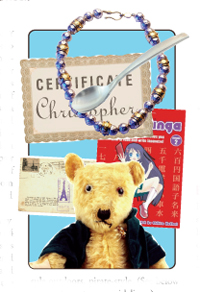If you do it right, building a family time capsule doesn’t mean you forgo massive profits in the garage-sale market. Not even that mouth-breather who pulls up in the ‘73 Le Mans would cast a second glance at the stuff I crave from my formative years: a faded menu from the Stockyard restaurant at Aurora Village; the primitive “phaser” I carved from wood lath and used to stun the housecat; a pair of Toughskins jeans; the tube of “Vampire Blood” I purloined from Fred Meyer; the can of lighter fluid and the subsequent police report.
 But I have none of that. Most of my youth is preserved on Kodachrome 64 slides inside a carousel in the recesses of Mom’s closet. Even if I mustered enough interest to find them and assemble the slide projector, the images would leave me hollow. There’s nothing tangible on those color transparencies, nothing that communicates directly from past to present.
But I have none of that. Most of my youth is preserved on Kodachrome 64 slides inside a carousel in the recesses of Mom’s closet. Even if I mustered enough interest to find them and assemble the slide projector, the images would leave me hollow. There’s nothing tangible on those color transparencies, nothing that communicates directly from past to present.
Thanks to either my growing appetite for nostalgia or the onset of dementia, I have decreed this winter the season of the Blaylock time capsule. If you have the means, have a go yourself. By all accounts, they are fun to assemble and even more fun to open, assuming someone remembers or even cares where it’s stashed. Below are some tips for building your own little piece of family history.
The vessel
Find something sturdy and moisture-resistant. A large Tupperware container will do, and include a bunch of gallon- and quart-size Ziploc bags for individual items. The Tupperware should be as large as possible — at least the size of two shoeboxes. (You can also use some smaller Tupperware containers for each child so they can have individual time capsules; in 10 years, nobody will remember whose Thomas that is.) Those large plastic storage bins at the hardware store are another option, but sealing them becomes an issue if you bury the capsule outdoors, pirate-style. (See below for outdoor storage guidelines.)
The artifacts
- Keep “top of mind” the words of “time capsule historian” William Jarvis, who laments that most time capsules are filled with “useless junk.”
- Consider including descriptions of each family member, a letter from you to your older self, a menu from a favorite restaurant, a certificate from a summer camp, a piece of jewelry your child wore every day for a year, a can’t-put-it-down toy catalog.
- Remember the adage “Comedy is tragedy plus time.” My parents burned the clothesline I used to tie up my brother, but that’s exactly the kind of memory that evokes guffaws around the dinner table these days.
- Items should be personal. Don’t bother keeping a news article you can find on Google later.
- Paper documents should be on acid-free paper or sprayed with paper antacid, available at craft stores.
- Storage devices such as CDs, DVDs, video- and audiotapes, etc. may not be playable in the future, what with media standards changing so quickly. NASA’s Voyager spacecraft, launched in 1977, is carrying a gold-plated phonograph record to communicate with alien beings. To most of us, that’s the modern equivalent of a cave drawing.
- If you insist on using recordings, try to put them on a variety of media. Still, tangible content is the goal; I would trade 385 minutes of my parents’ home movies for my old G.I. Joe Sea Adventurer.
Pack it
Put each item in its own Ziploc and squeeze out the air. Store these in the larger Tupperware or plastic receptacle. It’s a good idea to include a list of the contents and their importance (see “clothesline” above) to help jog your memory. Be sure to include the packing date. Toss in a few silica gel packs (available at www.silicagelpackets.com) to control humidity. Then tie or tape the lid on.
Stash it
If you plan on staying at your current address for a while and know how to avoid the sewer line, you might want to bury the thing. Seal it well, augmenting seams with duct tape, if need be. Dig a hole 3 to 4 feet deep, well away from raging rivers, large trees and landfills. If you do bury it, you might consider including your name, e-mail address, telephone number and other contact information, lest you move away and forget it’s there. If you’re not into excavation, put the capsule in the attic or a deep closet, next to the slide carousel.
The opening ceremony
Wait at least 10, but no more than 20, years; remember, you’ll need some vestige of youthful strength to dig up the thing. I recommend a summer date. It’s not easy to poke a shovel into frozen ground.
Derek Blaylock lives in Seattle with his wife and two sons.
This article originally appeared in the September, 2008 print edition of ParentMap.









